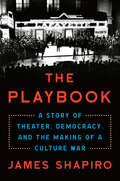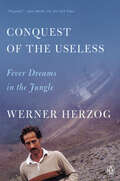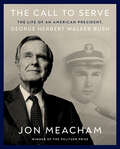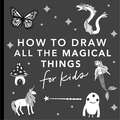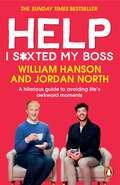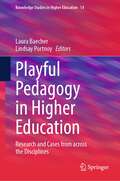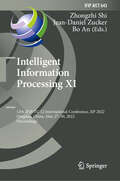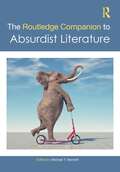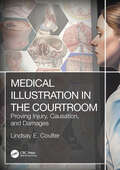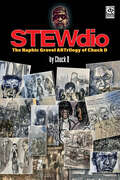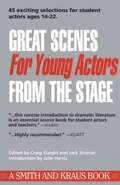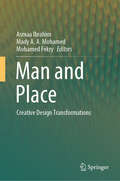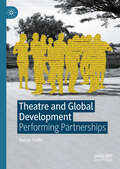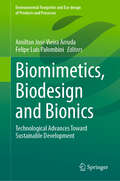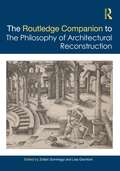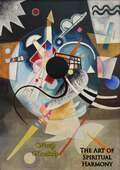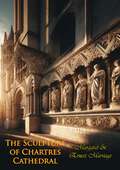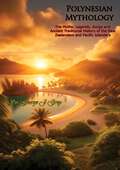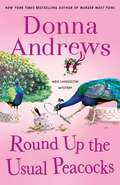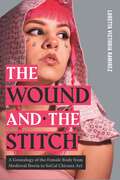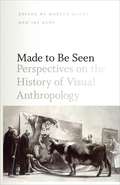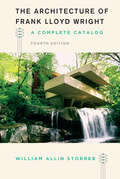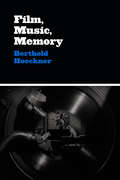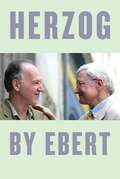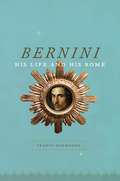- Table View
- List View
The Playbook: A Story of Theater, Democracy, and the Making of a Culture War
by James ShapiroA brilliant and daring account of a culture war over the place of theater in American democracy in the 1930s, one that anticipates our current divide, by the acclaimed Shakespeare scholar James ShapiroFrom 1935 to 1939, the Federal Theatre Project staged over a thousand productions in 29 states that were seen by thirty million (or nearly one in four) Americans, two thirds of whom had never seen a play before. At its helm was an unassuming theater professor, Hallie Flanagan. It employed, at its peak, over twelve thousand struggling artists, some of whom, like Orson Welles and Arthur Miller, would soon be famous, but most of whom were just ordinary people eager to work again at their craft. It was the product of a moment when the arts, no less than industry and agriculture, were thought to be vital to the health of the republic, bringing Shakespeare to the public, alongside modern plays that confronted the pressing issues of the day—from slum housing and public health to racism and the rising threat of fascism. The Playbook takes us through some of its most remarkable productions, including a groundbreaking Black production of Macbeth in Harlem and an adaptation of Sinclair Lewis&’s anti-fascist novel It Can&’t Happen Here that opened simultaneously in 18 cities, underscoring the Federal Theatre&’s incredible range and vitality. But this once thriving Works Progress Administration relief program did not survive and has left little trace. For the Federal Theatre was the first New Deal project to be attacked and ended on the grounds that it promoted &“un-American&” activity, sowing the seeds not only for the McCarthyism of the 1950s but also for our own era of merciless polarization. It was targeted by the first House un-American Affairs Committee, and its demise was a turning point in American cultural life—for, as Shapiro brilliantly argues, &“the health of democracy and theater, twin born in ancient Greece, have always been mutually dependent.&”A defining legacy of this culture war was how the strategies used to undermine and ultimately destroy the Federal Theatre were assembled by a charismatic and cunning congressman from East Texas, the now largely forgotten Martin Dies, who in doing so pioneered the right-wing political playbook now so prevalent that it seems eternal.
Conquest of the Useless: Fever Dreams in the Jungle
by Werner HerzogNewly repackaged as a Penguin paperback, Conquest of the Useless, the legendary filmmaker Werner Herzog's diary of the making of Fitzcarraldo, one of his most revered and classic filmsIn 1982, the visionary directory Werner Herzog released Fitzcarraldo, a lavish film about a would-be rubber baron who pulls a 320-ton steamship over a mountain. It was hailed instantly by critics around the globe as a masterpiece and won Herzog the 1982 Outstanding Director Prize at the Cannes Film Festival, affirming Herzog&’s reputation as one of the most revered and enigmatic filmmakers of his time.Conquest of the Useless is the diary Herzog kept during the making of Fitzcarraldo, compiled from June 1979 to November 1981. Emerging as if out of an Amazonian fever dream during filming, Herzog&’s writings are an extraordinary documentary unto themselves. Strange and otherworldly events are recounted by the filmmaker. The crew's camp in the heart of the jungle is attacked and burned to the ground; the production of the film clashes with a border war; and, of course, Herzog unravels the impossible logistics of moving a 320-ton steamship over a hill without the use of special effects.In his preface, Herzog warns that the diary entries collected in Conquest of the Useless do not represent &“reports on the actual filming&” but rather &“inner landscapes, born of the delirium of the jungle.&” Thus begins an extraordinary glimpse into the mind of a genius during the making of one of his greatest achievements.
The Call to Serve: The Life of an American President, George Herbert Walker Bush: A Visual Biography
by Jon MeachamIn honor of the one hundredth anniversary of George H. W. Bush&’s birth, this visually stunning chronicle features never-before-published photos and memories celebrating the forty-first president&’s vision of leadership as service to country—curated by Pulitzer Prize–winning biographer Jon Meacham.Lavishly illustrated, The Call to Serve is an intimate, illuminating portrait of the forty-first president, a man who was so much more than just his politics. In words and images—many found in a lifetime of scrapbooks kept by Barbara Pierce Bush—Jon Meacham brings George H. W. Bush vividly to life. From the values of integrity, empathy, and grace that Bush learned in childhood to his leadership at the highest levels in tumultuous times, the forty-first president embodied an ideal of service that warrants attention in our own divided time.Bush pursued a life of service to America through his heroic combat experience in the Pacific during World War II, his political rise in Texas, his serving as U.S. ambassador to the UN, his time as envoy to China and as director of the CIA, his tenure as Ronald Reagan&’s vice president, and his election as the forty-first president of the United States. Set against the background of America during the twentieth and twenty-first centuries, this book commemorates the legacy of a man who was far from perfect—he could be cutthroat on the campaign trail—but whose ambition was not an end unto itself. Bush&’s drive to succeed was, rather, a means to put the values of balance, patriotism, and respect for others into action in the political arena. Toward the end of Bush&’s life, the forty-fourth president, Barack Obama, said that Bush put the country first &“both before he was president, while he was president, and ever since.&”Featuring more than 450 photographs, Meacham&’s introduction and commentary throughout, and narration drawn from his biography of George H. W. Bush, Destiny and Power, this is an essential tribute to a uniquely American life.
Magical Things: How to Draw Books for Kids with Unicorns, Dragons, Mermaids, and More (How to Draw For Kids Series)
by Alli KochLearn to draw with fun 5-minute drawing lessons for kids—great for young artists, birthday gifts, homeschool art lessons, and elementary art classes!Perfect for budding artists and kids who have never drawn before, this new drawing book for kids will teach your child how to draw unicorns and other magical creatures in no time! Author and professional artist Alli Koch's kid-friendly, mini drawing lessons will help your child practice their basic art skills and teach them how to draw with confidence. This how to draw book is perfect for kids 7-12, but kids as young as 5 with an interest in art will be able to easily follow along as well. No experience required!Easy-to-Follow Instructions: Simple steps and diagrams from start to finish40+ Cool Projects for Both Boys and Girls: Learn how to draw a mermaid, fairy, genie, ogre, and other fun magical creaturesLayflat Binding: Making it easier for kids to keep the book open as they follow alongPerforated Pages and Premium Paper: Easily removable pages that are thick and sturdy, and the foil on the cover will catch kids' eyes!9 x 9 Size: Big pages so your kid has no problem seeing each step
Help I S*xted My Boss: The Sunday Times Bestselling Guide to Avoiding Life’s Awkward Moments
by William Hanson Jordan North'Funny, filthy and fantastic. Cackled from start to finish' - Rylan ClarkHow do you ask your mate for that £50 back?When is OK to trump in front of your partner?And what should you do if you've accidentally sexted your boss?William and Jordan are from very different worlds.William's an etiquette expert, with his tongue firmly in his teacup and unparalleled knowledge of table linen. Jordan's a TV and radio presenter, the patron saint of Burnley and an expert in all things common. Together they've entertained millions of listeners worldwide with their hit podcast Help I Sexted My Boss.Now, they’ve pooled all of their wisdom on how to get through life’s most awkward moments.From candlelight suppers to picky teas, first dates to flatmate dramas, Help I Sexted My Boss is full of both useful and useless advice. This is your indispensable guide to navigating the trepidation and challenges of modern life.'Hilarious lads.. and weirdly useful. This generation’s Ant and Dec. If one of them was really posh. Great read' - Vicky PattisonSunday Times Bestseller, November 2023
Playful Pedagogy in Higher Education: Research and Cases from across the Disciplines (Knowledge Studies in Higher Education #14)
by Laura Baecher Lindsay PortnoyThis collection provides a wide array of concrete and inspiring "playful" approaches to teaching in a range of higher education contexts and discipline areas, grounded in the learning sciences and within a future-oriented revisioning of the university learning environment. Within the broad area of active learning strategies, this text offers a curated collection of creative innovations such as game-based learning, gamification of courses, escape rooms, semester-long quests, dramatic role-plays, artistic endeavors and more. Containing descriptive and impact research that evidences the power of playful pedagogy, this text will offer a range of novel, transferable and usable materials for readers to apply in their lecture halls and classrooms tomorrow.
Intelligent Information Processing XI: 12th IFIP TC 12 International Conference, IIP 2022, Qingdao, China, May 27–30, 2022, Proceedings (IFIP Advances in Information and Communication Technology #643)
by Bo An Jean-Daniel Zucker Zhongzhi ShiThis book constitutes the refereed proceedings of the 12th IFIP TC 12 International Conference on Intelligent Information Processing, IIP 2022, held in Qingdao, China, in July 2022. The 37 full papers and 6 short papers presented were carefully reviewed and selected from 57 submissions. They are organized in topical sections on Machine Learning, Data Mining, Multiagent Systems, Social Computing, Blockchain Technology, Game Theory and Emotion, Pattern Recognition, Image Processing and Applications.
The Routledge Companion to Absurdist Literature (Routledge Literature Companions)
by Michael Y. BennettThe Routledge Companion to Absurdist Literature is the first authoritative and definitive edited collection on absurdist literature. As a field-defining volume, the editor and the contributors are world leaders in this ever-exciting genre that includes some of the most important and influential writers of the twentieth century, including Samuel Beckett, Harold Pinter, Edward Albee, Eugene Ionesco, Jean Genet, and Albert Camus. Ever puzzling and always refusing to be pinned down, this book does not attempt to define absurdist literature, but attempts to examine its major and minor players. As such, the field is indirectly defined by examining its constituent writers. Not only investigating the so-called “Theatre of the Absurd,” this volume wades deeply into absurdist fiction and absurdist poetry, expanding much of our previous sense of what constitutes absurdist literature. Furthermore, long overdue, approximately one-third of the book is devoted to marginalized writers: black, Latin/x, female, LGBTQ+, and non-Western voices.
Medical Illustration in the Courtroom: Proving Injury, Causation, and Damages
by Lindsay E. CoulterMedical Illustration in the Courtroom: Proving Injury, Causation, and Damages educates the reader on how to communicate science visually—in personal injury, medical malpractice, criminal, and forensic cases—by creating art that utilizes medical records, radiographs, and computer software. Medical illustration bridges the gap between complex technical, medical, and scientific concepts to clearly illustrate, and explain visually, a medical condition, negligence, or the causation of an injury or death to the lay person. Medical artists are frequently challenged with illustrating injuries and medical conditions that can’t be seen by the naked eye. And while using medical photography and imaging for illustrative purposes can be helpful, to an untrained eye it can often be unclear or confusing. This is where the medical illustrator enters the equation. There are often patients who have recovered from an injury or infection that appear in good health. However, should an unforeseen injury or fatality happen, medical illustrators can reveal to people what’s actually going on inside the person, an invaluable asset to attorneys in the courtroom—especially for personal injury and medical malpractice cases. While many attorneys utilize medical artists, nonvisual people don’t always recognize the value of demonstrative aids until they see them first-hand.When attorneys and their clients enlist the aid of medical artists, it quickly becomes apparent that properly conceived and executed artwork is invaluable to illustrating the facts—and medical impacts—of any number of scenarios: homicides by shooting, stabbings, vehicular accidents, in addition to medical malpractice and personal injuries resulting from surgery or possible negligence.Presenting a myriad of services and computer technologies that can be utilized, Medical Illustration in the Courtroom provides demonstrative aids used in cases to illustrate personal injury and medical malpractice, employing "tricks of the trade" to create an accurate effective image. Such images are educational to attorneys, insurance adjusters, judges, and juries to help create a visual storyline, the goal being to help combine art and science to provide a clear illustration of events to help in adjudicate legal and forensic cases.
STEWdio: The Naphic Grovel Artrilogy Of Chuck D
by Chuck DChuck D (Public Enemy, Prophets of Rage, etc.) brings his personal insights and social critiques to the page in fierce, passionate, and evocative visual art and prose "The Public Enemy mastermind combines art and hip-hop rhymes to provide his compelling, personal views on the chaotic years between 2020 and 2022. Though they often feel like diary entries, each installment has an overarching storyline and theme . . . In an engaging, distinctly hip-hop style, Chuck D reveal important lessons from the early pandemic years." —Kirkus Reviews, Starred Review Legendary hip-hop artist and social activist Chuck D has used every opportunity in his groundbreaking career to stand up for civil rights. His rap group Public Enemy is widely regarded as a revolutionary act both in terms of its impact on hip-hop and its use of music to impart a message of race and class equality. The band emerged from the late 1970s/early '80s coalescence of rap, punk, and street art into hip-hop music culture on the East Coast. At the time, Chuck D had completed his BFA in graphic design, and while his music career exploded, his passion for visual art never left his heart. In February 2020, he turned his gaze once again to the page, and began to fill three 5 x 8 journals with his written and drawn reflections of a world beginning to unravel. STEWdio: The Naphic Grovel ARTrilogy of Chuck D recreates format of his original art, combining three full-color paperback bound books into a beautiful box set. The box set is the inaugural offering from Enemy Books, the new Akashic Books imprinted curated by Chuck D. Spanning the onset of COVID-19 through the first year of the Joe "Bye-Don" administration, Chuck D lends his powerful artistic voice to one of the most tumultuous periods in American history, and puts it in a capsule. Like the neo-expressionist graffiti art of Jean-Michel Basquiat, Chuck D's energetic "Naphic Grovels" marry text with drawings, commenting on contemporary events with the same activist instinct that propelled Public Enemy's "music-with-a-message" reputation. His inventive, Amiri Baraka–esque language and accompanying art is also occasionally used as a tool for introspection, providing unparalleled insight into one of the most important cultural figures of our time. Each journal follows a distinct period in Chuck D's (and America's) life; There's a Poison Goin On chronicles the onset of the COVID-19 pandemic, from February–April 2020; 45 Daze of REaD Octobot follow the days leading up to and the aftermath of the historic 2020 election; and Datamber Mindpaper, which focuses on the early days of the Biden administration. No song may be more reflective of 1980s America than Public Enemy's "Fight the Power;" no document may come to capture our COVID era like Chuck D's STEWdio.
Great Scenes For Young Actors From The Stage (Young Actors Ser.)
by Craig Slaight Jack SharrarGreat Scenes for Young Actors (Young Actors Series)
Man and Place: Creative Design Transformations
by Asmaa Ibrahim Mohamed Fekry Mady A. A. MohamedThis book is a result of the 1st ARCH and DESN International Conference (previously Memaryat) Conference held at Effat university on the 8th and 9th of February 2023, and includes chapters dealing with the critical manifestation of “Man and Place” to accommodate and embrace social, economic, and environmental needs within a balanced, integrated system.The book is groundbreaking in that it brings together some of the brightest minds in academia and industry. The book includes a diverse range of contributions from esteemed academics and practitioners and offers a unique platform for thought-provoking discussions and innovative strategies that will help shape the cities of tomorrow.Further chapters include topics such as sustainability and creative transformations, smart cities, environmental resilience, resilient local economies, manufacturing innovations, and smart products. This book will be of interest to decision-makers, architects, interior designers, product designers, urban planners, urban designers, entrepreneurs, educators, and agencies.
Theatre and Global Development: Performing Partnerships
by Bobby SmithHow do theatre and development partnerships operate? What issues impede collaborations between various institutions and individuals? Why do relations between global North and South partners often fail to reflect important values such as equality, reciprocity and mutual benefit? This is the first book to examine theatre and global development partnerships. It focusses on the UK and East African countries of Kenya, Rwanda and Uganda, presenting the author’s own experiences, case study analyses and perspectives from practitioners and scholars involved in theatre and development. It argues that simplistic binaries pervade partnerships, whereby the global North is regarded as ‘modern’ and ‘developed’ versus the ‘under-developed’ global South. This results in unequal power relations between collaborators, less effective projects with communities, and a lack of reciprocity and mutual benefit. Consequently, this book revitalises how we conceptualise partnerships. Issues such as widening inequalities, conflict, health and the climate crisis impact all countries. How, then, can we work across borders to support interconnected learning and action on these challenges? In this regard, principles of solidarity and mutual responsibility, as well as critical openness, enable us to reflect honestly about the failures of the partnerships we participate in and move beyond simplistic binaries of global North and South. The book is of importance to applied and socially engaged performance scholars and practitioners, and to development workers interested in arts and social change.
Biomimetics, Biodesign and Bionics: Technological Advances Toward Sustainable Development (Environmental Footprints and Eco-design of Products and Processes)
by Felipe Luis Palombini Amilton José Vieira ArrudaNature is a vast source of inspiration and information for the resolution of complex problems and can influence many varieties of design. Biomimetics, biodesign and bionics are three branches of interdisciplinary research merging biological and applied sciences. This volume collects cases that highlight recent breakthroughs in these disciplines. Biological features such as patterns, shapes, mechanisms, colors, structures, and more can be analyzed, organized, and modeled for application in human creations. Therefore, design, engineering, and architecture projects can benefit from solutions that were already tested and verified through evolution in the natural world. With the development of new technologies for the investigation, simulation, and testing of natural features, the path from nature to product can be accelerated. The cases presented in this work showcase how technological advancements are leading to improved design solutions and influencing our very comprehension of natureand its complex organization.
The Routledge Companion to the Philosophy of Architectural Reconstruction
by Lisa Giombini Zoltán SomhegyiThis companion investigates the philosophical and theoretical foundations determining the conditions of possibility and the limits that make the conservation, readaptation, and transformation of past buildings legitimate operations.As increasing ecological and economic challenges question opportunities for new construction, the process of restoring, transforming, and readapting buildings for new or continued use is becoming an essential part of architectural practice. At the same time, the role of building conservation is changing from mere material preservation to being part of a broader strategy for social regeneration, eco-awareness, and inclusive urban planning. Chapters of this volume explore the complex set of considerations that inform decisions to merely preserve, accurately restore or variously reuse a building. They also look at the broader philosophical concerns such as ethical and aesthetic values, combined with ideas of heritage, history, and collective identity. Case studies on reconstruction after war, gentrification, the restoration of ancient edifices, reconstruction following the effects of climate change, and the use of technology solutions among many others, make this a timely and urgent volume.Adopting a broad transcultural perspective with contributions from five continents, the volume combines theoretical approaches with more practical, case study-based investigations and will be of great interest to upper-level students and academics working in the fields of architecture, conservation, urban design, aesthetics, and heritage management.
The Art of Spiritual Harmony
by Wassily Kandinsky"The Art of Spiritual Harmony" is a seminal work by the pioneering abstract artist Wassily Kandinsky. This influential book delves into the profound connection between art and spirituality, presenting Kandinsky's revolutionary ideas on the role of art in expressing the innermost emotions and transcending the material world.Kandinsky, a master of color and form, articulates his belief that art should go beyond mere representation and tap into deeper spiritual truths. He explores the concept of "inner necessity," the driving force that compels true artists to create works that resonate on a spiritual level. Through a series of essays and reflections, Kandinsky discusses the transformative power of color, the significance of abstract forms, and the artist's role in society.Rich with philosophical insights and artistic theory, "The Art of Spiritual Harmony" offers readers a glimpse into Kandinsky's visionary mind. The book is adorned with illustrations of his groundbreaking paintings, showcasing his journey from figurative art to pure abstraction. Kandinsky's writings inspire artists and art lovers to seek harmony between the spiritual and the aesthetic, encouraging them to view art as a means of personal and collective enlightenment.This timeless work remains a cornerstone of modern art theory, providing invaluable guidance for anyone interested in the spiritual dimensions of artistic expression. "Kandinsky - The Art of Spiritual Harmony" is a must-read for artists, scholars, and anyone seeking to understand the profound relationship between art and the human spirit.
The Sculpture of Chartres Cathedral: Text In English And French; Texte Francais Et Anglais (classic Reprint)
by Margaret Marriage Ernest Marriage“The book ""Sculptures of Chartres Cathedral"" by Margaret Marriage is a comprehensive guide to the magnificent sculptures that adorn the Chartres Cathedral in France. The book provides a detailed account of the history of the cathedral and its sculptures, as well as an analysis of the artistic techniques and styles used to create them. The book is divided into several chapters, each of which focuses on a different aspect of the sculptures. The first chapter provides an overview of the cathedral and its history, while the second chapter explores the iconography of the sculptures and the religious themes they represent. The third chapter delves into the technical aspects of the sculptures, such as the materials used and the methods of construction. The fourth chapter examines the influence of different artistic styles on the sculptures, including Romanesque and Gothic. The book also includes numerous photographs and illustrations to help readers visualize the sculptures and understand their significance. Overall, ""Sculptures of Chartres Cathedral"" is an essential resource for anyone interested in medieval art and architecture, and a must-read for those planning a visit to the Chartres Cathedral... It deals mainly with the sculptures on the doorway, although there are views of the general architecture and a few subjects from the interior. Over 120 photographs,”-Print ed.
Polynesian Mythology: The Myths, Legends, Songs and Ancient Traditional History of the New Zealanders and Pacific Islanders
by Sir George J Grey“Sir George Grey was among the first chroniclers to explore Hawaii and the South Sea Isles with an aim of writing down the local legends and myths - this collection contains the amazing results of his journey.It was not the author's original plan to record the myths and legends of the Polynesian people - a government posting in New Zealand, and his subsequent encounters with natives and their chieftains, spurred an interest in the region's rich storytelling history. Many chieftains would quote different proverbs and narratives in common, summarizing the deeds of heroes such as Maui and Tawhaki. Many of the myths and legends reflected the Polynesian society's maritime nature - prowess upon the seas, be it in intrepid sailing or hunting great beasts of the deep, is a recurring theme.The peoples of Polynesia were spread over thousands of miles of island chains in the Pacific Ocean, and were mindful of the great distances their boats had covered. The discovery of New Zealand itself was subject to a legendary story; it being an island far greater in size than any discovered before. Tales of rituals and magic connected with nature leads Sir Grey to speculate about some arcane link between Polynesia and ancient Mexico - at the time, the supernatural qualities found in this lore were considered barbarous, and ignoble in the face of the Christianity of Western explorers.”-Print ed.
Round Up the Usual Peacocks: A Meg Langslow Mystery (Meg Langslow Mysteries #31)
by Donna AndrewsNew York Times bestselling author Donna Andrews first introduced us to Meg Langslow as a crime-solving bridesmaid. In her 31st mystery, Round Up the Usual Peacocks, Meg returns to her roots, juggling cold cases and wedding guests.Kevin, Meg's cyber-savvy nephew who lives in the basement, comes to her with a problem. He's become involved as the techie for a true-crime podcast, one that focuses on Virginia cold cases and unsolved crimes. And he thinks their podcast has hit a nerve with someone . . . one of the podcast team has had a brush with death that Kevin thinks was an attempted murder, not an accident.Kevin rather sheepishly asks for Meg's help in checking out the people involved in a couple of the cases. "Given your ability to find out stuff online, why do you need MY help?" she asks. "Um . . . because I've already done everything I can online. This'll take going around and TALKING to people," he exclaims, with visible horror. "In person!" Not his thing. And no, it can't wait until after the wedding, because he's afraid whoever's after them might take advantage of the chaos of the wedding at Trinity or the reception at Meg and Michael's house to strike again.So on top of everything she's doing to round up vendors and supplies and take care of demanding out-of-town guests, Meg must hunt down the surviving suspects from three relatively local cold cases so she can figure out if they have it in for the podcasters. Could there be a connection to a musician on the brink of stardom who disappeared two decades ago and hasn't been seen since?
The Wound and the Stitch: A Genealogy of the Female Body from Medieval Iberia to SoCal Chicanx Art (RSA Series in Transdisciplinary Rhetoric)
by Loretta Victoria RamirezThe Wound and the Stitch traces a history of imagery and language centered on the concept of woundedness and the stitching together of fragmented selves. Focusing particularly on California and its historical violences against Chicanx bodies, Loretta Victoria Ramirez argues that woundedness has become a ubiquitous and significant form of Chicanx self-representation, especially in late twentieth-century print media and art.Ramirez maps a genealogy of the female body from late medieval Iberian devotional sculptures to contemporary strategies of self-representation. By doing so, she shows how wounds—metaphorical, physical, historical, and linguistic—are inherited and manifested as ongoing violations of the body and othered forms of identity. Beyond simply exposing these wounds, however, Ramirez also shows us how they can be healed—or rather stitched. Drawing on Mesoamerican concepts of securing stability during lived turmoil, or nepantla, Ramirez investigates how creators such as Cherríe Moraga, Renee Tajima-Peña, Guillermo Gómez-Peña, and Amalia Mesa-Bains repurpose the concept of woundedness to advocate for redress and offer delicate, ephemeral moments of healing.Positioning woundedness as a potent method to express Chicanx realities and transform the self from one that is wounded to one that is stitched, this book emphasizes the necessity of acknowledgment and ethical restitution for colonial legacies. It will be valued by scholars and students interested in the history of rhetorics, twentieth-century Chicanx art, and Latinx studies.
Made to Be Seen: Perspectives on the History of Visual Anthropology
by Marcus Banks and Jay RubyMade to be Seen brings together leading scholars of visual anthropology to examine the historical development of this multifaceted and growing field. Expanding the definition of visual anthropology beyond more limited notions, the contributors to Made to be Seen reflect on the role of the visual in all areas of life. Different essays critically examine a range of topics: art, dress and body adornment, photography, the built environment, digital forms of visual anthropology, indigenous media, the body as a cultural phenomenon, the relationship between experimental and ethnographic film, and more. The first attempt to present a comprehensive overview of the many aspects of an anthropological approach to the study of visual and pictorial culture, Made to be Seen will be the standard reference on the subject for years to come. Students and scholars in anthropology, sociology, visual studies, and cultural studies will greatly benefit from this pioneering look at the way the visual is inextricably threaded through most, if not all, areas of human activity.
The Architecture of Frank Lloyd Wright: A Complete Catalog
by William AllinFrom sprawling houses to compact bungalows and from world-famous museums to a still-working gas station, Frank Lloyd Wright’s designs can be found in nearly every corner of the country. While the renowned architect passed away more than fifty years ago, researchers and enthusiasts are still uncovering structures that should be attributed to him. William Allin Storrer is one of the experts leading this charge, and his definitive guide, The Architecture of Frank Lloyd Wright, has long been the resource of choice for anyone interested in Wright. Thanks to the work of Storrer and his colleagues at the Rediscovering Wright Project, thirty-seven new sites have recently been identified as the work of Wright. Together with more photos, updated and expanded entries, and a new essay on the evolution of Wright’s unparalleled architectural style, this new edition is the most comprehensive and authoritative catalog available. Organized chronologically, the catalog includes full-color photos, location information, and historical and architectural background for all of Wright’s extant structures in the United States and abroad, as well as entries for works that have been demolished over the years. A geographic listing makes it easy for traveling Wright fans to find nearby structures and a new key indicates whether a site is open to the public. Publishing for Wright’s sesquicentennial, this new edition will be a trusted companion for anyone embarking on their own journeys through the wonder and genius of Frank Lloyd Wright.
Film, Music, Memory (Cinema and Modernity)
by Berthold HoecknerFilm has shaped modern society in part by changing its cultures of memory. Film, Music, Memory reveals that this change has rested in no small measure on the mnemonic powers of music. As films were consumed by growing American and European audiences, their soundtracks became an integral part of individual and collective memory. Berthold Hoeckner analyzes three critical processes through which music influenced this new culture of memory: storage, retrieval, and affect. Films store memory through an archive of cinematic scores. In turn, a few bars from a soundtrack instantly recall the image that accompanied them, and along with it, the affective experience of the movie. Hoeckner examines films that reflect directly on memory, whether by featuring an amnesic character, a traumatic event, or a surge of nostalgia. As the history of cinema unfolded, movies even began to recall their own history through quotations, remakes, and stories about how cinema contributed to the soundtrack of people’s lives. Ultimately, Film, Music, Memory demonstrates that music has transformed not only what we remember about the cinematic experience, but also how we relate to memory itself.
Herzog by Ebert
by Roger EbertRoger Ebert was the most influential film critic in the United States, the first to win a Pulitzer Prize. For almost fifty years, he wrote with plainspoken eloquence about the films he loved for the Chicago Sun-Times, his vast cinematic knowledge matched by a sheer love of life that bolstered his appreciation of films. Ebert had particular admiration for the work of director Werner Herzog, whom he first encountered at the New York Film Festival in 1968, the start of a long and productive relationship between the filmmaker and the film critic.Herzog by Ebert is a comprehensive collection of Ebert’s writings about the legendary director, featuring all of his reviews of individual films, as well as longer essays he wrote for his Great Movies series. The book also brings together other essays, letters, and interviews, including a letter Ebert wrote Herzog upon learning of the dedication to him of “Encounters at the End of the World;” a multifaceted profile written at the 1982 Cannes Film Festival; and an interview with Herzog at Facet’s Multimedia in 1979 that has previously been available only in a difficult-to-obtain pamphlet. Herzog himself contributes a foreword in which he discusses his relationship with Ebert. Brimming with insights from both filmmaker and film critic, Herzog by Ebert will be essential for fans of either of their prolific bodies of work.
Bernini: His Life and His Rome
by Franco MormandoSculptor, architect, painter, playwright, and scenographer, Gian Lorenzo Bernini (1598–1680) was the last of the great universal artistic geniuses of early modern Italy, placed by both contemporaries and posterity in the same exalted company as Leonardo, Raphael, and Michelangelo. And his artistic vision remains palpably present today, through the countless statues, fountains, and buildings that transformed Rome into the Baroque theater that continues to enthrall tourists today.It is perhaps not surprising that this artist who defined the Baroque should have a personal life that itself was, well, baroque. As Franco Mormando’s dazzling biography reveals, Bernini was a man driven by many passions, possessed of an explosive temper and a hearty sex drive, and he lived a life as dramatic as any of his creations. Drawing on archival sources, letters, diaries, and—with a suitable skepticism—a hagiographic account written by Bernini’s son (who portrays his father as a paragon of virtue and piety), Mormando leads us through Bernini’s many feuds and love affairs, scandals and sins. He sets Bernini’s raucous life against a vivid backdrop of Baroque Rome, bustling and wealthy, and peopled by churchmen and bureaucrats, popes and politicians, schemes and secrets.The result is a seductively readable biography, stuffed with stories and teeming with life—as wild and unforgettable as Bernini’s art. No one who has been bewitched by the Baroque should miss it.
